The Samsung Galaxy Note5 and Galaxy S6 edge+ Review
by Joshua Ho on October 2, 2015 8:00 AM ESTDisplay
With the rise of smartphones and tablets, the display has become one of the most important aspects of a mobile device as it’s the primary mode of interaction. However, throughout computing the display has generally had relatively little attention. People might have talked about resolution, size, and latency, but the discourse was vague at best. In order to really understand displays, it’s important to discuss a number of factors that affect display quality and the underlying design of the display. These factors range from subpixel arrangement to TFT structure and various emitter materials. With traditional reviewing methods, it’s often difficult to say one way or another whether one display is “better” than another. While simple metrics like maximum brightness can be compared in a relative manner, it’s hard to say whether one has better colors or higher static contrast. In order to test these metrics, we turn to objective measurements from devices like X-Rite’s i1Pro2 spectrophotometer and i1Display Pro colorimeter. In order to acquire the data from these devices and present it in a usable manner, we use SpectraCal’s CalMAN 5 with a custom workflow.
Under the microscope and based upon some quick viewing angle tests, subjectively the Galaxy Note5 display looks and feels like a bigger version of the Galaxy S6 display. Viewing angles for some angles feels like the display is almost painted on to the glass below, but some odd interference effects with viewing angle changes breaks the illusion to some extent. In the case of the S6 edge+, the curved edges of the display cause a noticeable shift in luminance when looking at the edge compared to the center of the display, which also causes an odd green shift which is probably due to the RGBG subpixel layout. I suspect the best LCDs will still be better at the “painted to the glass” illusion for the near future. This isn’t a huge deal, but it is a noticeable difference.
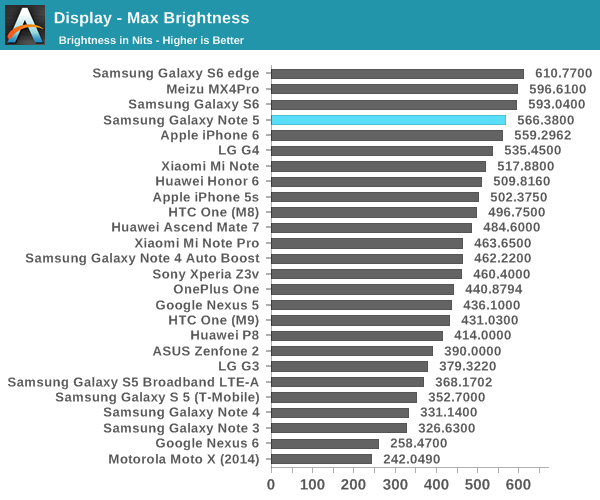
Moving on to our brightness testing, we can see that the Galaxy Note5 delivers a healthy improvement over the Galaxy Note 4 generation of AMOLED, but it isn’t quite at the same level as the Galaxy S6. It isn’t clear why this is the case, but I suspect this is related to longevity and other concerns outside of brightness. Meanwhile the use of OLED means that black levels are perfect and contrast remains solely determined by the lighting of the room and the reflectance of the display, which is similar to most other smartphones.
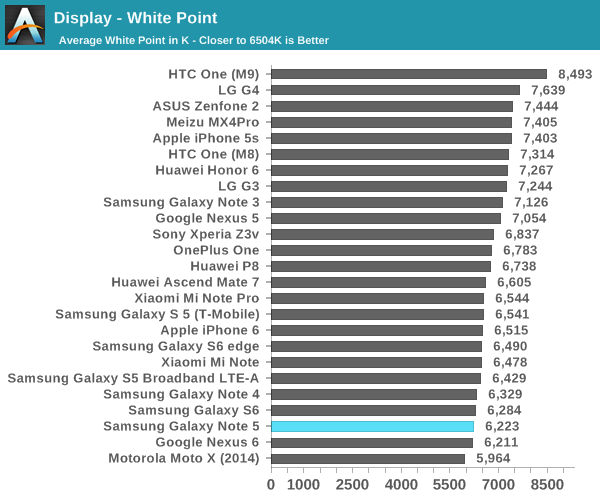
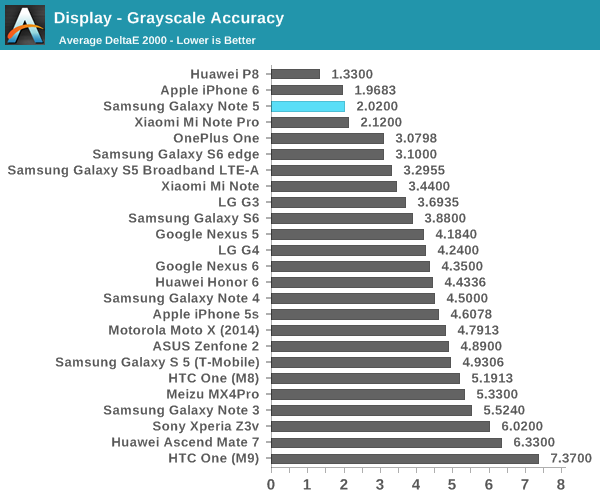
In our standard grayscale testing, the Note5 delivers acceptable color accuracy but it seems that the Basic screen mode tends towards a warm color balance. I suspect this helps with power efficiency, as blue in general requires more power to achieve the same level of luminance. Other than this slightly warm white balance, the grayscale accuracy doesn’t have any significant errors. This means accuracy ends up very good - certainly below our threshold for noticable errors - especially in comparison to the Galaxy Note 4 which had some noticeable problems with green tint on some units.
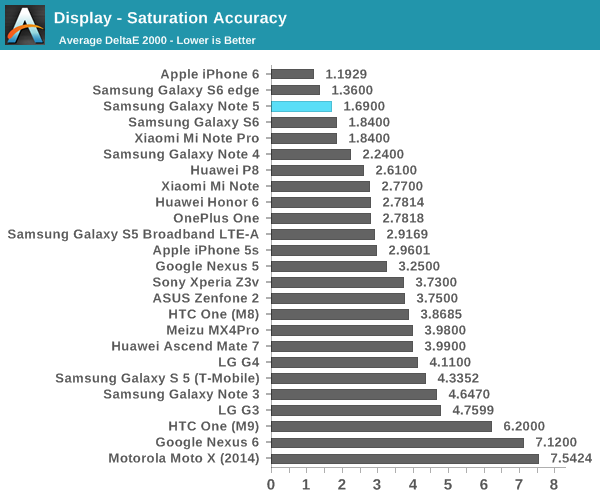
In our saturation test, Samsung does well enough that there’s really nothing to talk about because there's so little wrong here. You could argue that magenta is a bit warm on our review unit, but the difference is too small to be worth talking about. Error on average is going to be hard to spot unless you have a flawless reference monitor to compare against.
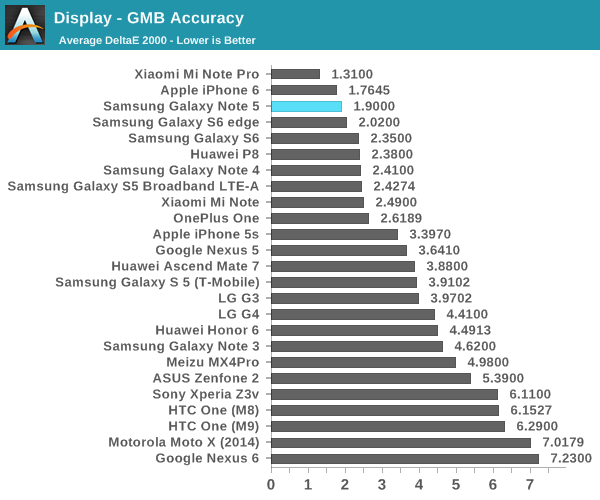
In the GMB ColorChecker test, Samsung continues to show a strong performance when looking at various hues that are commonly found in consumer content such as movies and camera photos. There’s a slight red shift on some of the tested hues, but the error is so minor I don’t notice that any problems here.
Overall, the Galaxy Note5 and Galaxy S6 edge+ both have an incredible display. The Galaxy S6 edge+ does have some problems with viewing angle shifts by virtue of the curved display, but this is effectively unavoidable given the subpixel layout and the radius of curvature. With this generation of AMOLED, Samsung has definitely equaled the best LCDs on the market. I suspect within the next year or two it will be inevitable that Samsung AMOLED will be clearly superior to even the best LCDs. However, without other OLED suppliers that can provide similar quality and cost I suspect OEM adoption will continue to be limited.



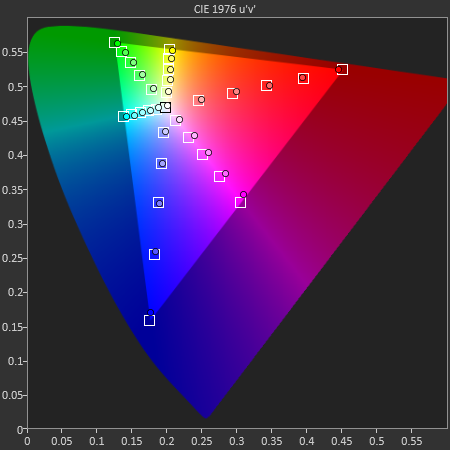
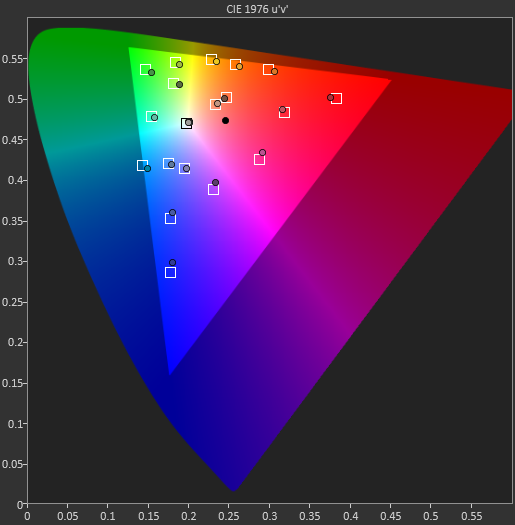








225 Comments
View All Comments
Sailor23M - Saturday, October 3, 2015 - link
Well said.just4U - Wednesday, October 7, 2015 - link
While not a fanboy.. (it's a phone for (censored) sake..) I do use Samsung phones pretty much exclusively these days simply because I am familiar with them and I've yet to see a company make one I like better.. That being said.. I am a long reader and commenter here as well.. and I certainly don't see any hate-on for any company or love-in for that matter.Occasionally some reviewers may know they have a certain amount of bias for some companies and may go overboard in trying to be fair ..coming across as to critical.. but that's pretty rare.
Tech_guy - Friday, October 2, 2015 - link
Apple is designing extremely fast chips these days with amazing performance combined with iOS 9, it's hard to deny that iPhone 6s is the leader right now, by a LONG shot.nerd1 - Friday, October 2, 2015 - link
Only thing 6s is better is better singlethread performance and GPU. 7420 still has better multithread performance (which android does use, says anandtech article!) and comes with better and larger display, smaller and lighter device, and true wacom pen and better camera.I just don't get it how 6s is "the leader" as it lacks in many division compared to now old GS6.
Tech_guy - Friday, October 2, 2015 - link
It's not about the quanity of your cores but their quality. Just look at how Intel obliterates AMD because of their stronger IPC in each core. It's not of the same Apple has set the single core benchmark so high that others will HAVE to focus on single core performance. What some real world comparisons of iPhone 6s vs Note 5, anytime it's a larger app like a game or something the iPhone 6s just destroys those weak cores in the Exynos 7422.thedons1983 - Sunday, October 18, 2015 - link
What a moronic comment! If your assertion were actually true, then literally everyone would buy an iPhone. They don't, however, because not everyone wants to suck on apples tainted teat. Their software is utter garbage, and the only reason they close it down so much, is because they know that it would simply break otherwise. IOS is woeful, as is OS-x, hence why user rates are so incredibly low. Even windows 8, which lots of people hated, has user numbers that OS-X could only dream of. Primarily, it's because windows is just better. Android beats IOS in almost every respect, and the only people that can't comprehend that, are idiot fanboys like you. You are actually, and truly, pathetic.Sailor23M - Saturday, October 3, 2015 - link
I have been a regular reader since 2003/04 time period - so a good 10+ years. Although I am an Apple user I do feel the site has progressively increased their bias/tilt towards Apple. If its true that "Galaxy Phones are pushing 4 times more pixels" then this should have been mentioned in the review.Kuzi - Saturday, October 3, 2015 - link
Galaxy S6/Edge/Note 5 resolution:2560x1440= 3686400 pixels
IPhone 6/6S resolution:
1334x750= 100500 pixels
The Galaxy phones are pushing 3.68 times more pixels than iPhone 6 & 6S.
Peichen - Monday, October 5, 2015 - link
Note 5 should be compared with iPhone 6s PLUS, not the regular size one. QHD on the regular S6 is just stupid but consider Samsung cheats with the sub-pixels counts on AMOLED the smaller screen does need QHD to not show pixels.Kuzi - Tuesday, October 6, 2015 - link
Even though the Galaxy S6 uses a non standard pixel arrangment, it's 575 PPI screen is much sharper than the comparatively low res (by today's standards) 325 PPI screen of the iPhone 6S.